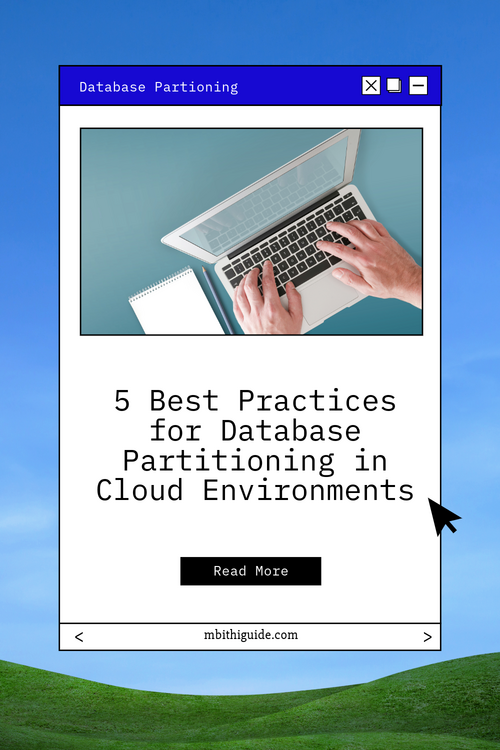Introduction
Hey there, fellow data enthusiast! So, you’ve decided to take your database to the cloud, huh? Smart move! But wait, before you dive headfirst into the world of cloud databases, there’s something you should know: database partitioning. Yeah, it might sound a bit technical, but trust me, understanding how to partition your database in the cloud can make a world of difference in terms of performance, scalability, and overall efficiency.
In this blog post, we’re going to break down the ins and outs of database partitioning in cloud environments. We’ll chat about why it’s essential, what strategies you can use, and most importantly, the best practices to follow. Whether you’re a seasoned database pro or just dipping your toes into the cloud waters, you’re bound to pick up some valuable tips and tricks along the way.
Benefits of Database Partitioning in the Cloud
1. Scalability
- Improved Performance: Database partitioning allows for distributing data across multiple nodes, reducing the workload on individual nodes and improving overall performance. This ensures that as your data grows, your database can scale horizontally to handle the increased load.
- Flexibility: Easily scale your database by adding or removing partitions based on changing workload requirements. This flexibility allows you to adapt to changing storage and performance needs without major disruptions to your database operations.
2. Cost Optimization
- Resource Efficiency: Partitioning can help optimize resource utilization, reducing costs associated with over-provisioning. By partitioning your data and allocating resources based on actual usage patterns, you can ensure that you’re only paying for what you need.
- Storage Savings: Store less frequently accessed data on cheaper storage solutions, saving costs. With partitioning, you can store historical or archival data on lower-cost storage options, while keeping frequently accessed data on high-performance storage, optimizing costs.
3. Performance
- Reduced Latency: By distributing data closer to where it’s needed, partitioning can reduce latency and improve response times. This is especially beneficial for applications that require real-time data access or low-latency processing.
- Parallel Processing: Partitioned databases can leverage parallel processing, improving query performance. By dividing data into smaller chunks, queries can be processed in parallel across multiple partitions, leading to faster query execution times and overall improved performance.
Types of Database Partitioning
Horizontal Partitioning
Horizontal partitioning, also known as sharding, involves dividing a table into multiple partitions, each containing a subset of the data rows. This type of partitioning is useful when you have a large dataset that can be logically divided based on a specific criterion, such as customer ID or geographic location.
- Benefits: Horizontal partitioning can improve query performance by distributing the data across multiple servers, allowing queries to be executed in parallel. It also provides scalability, as you can add more partitions as your data grows.
Vertical Partitioning
Vertical partitioning involves dividing a table into multiple partitions, each containing a subset of the columns. This type of partitioning is useful when you have tables with a large number of columns, but not all columns are frequently accessed together.
- Benefits: Vertical partitioning can improve query performance by reducing the amount of data that needs to be read from disk for each query. It can also help optimize storage costs, as you can store less frequently accessed columns on cheaper storage solutions.
Hybrid Partitioning
Hybrid partitioning is a combination of horizontal and vertical partitioning, where a table is partitioned both horizontally and vertically. This type of partitioning is useful when you have complex data access patterns that cannot be fully addressed by horizontal or vertical partitioning alone.
- Benefits: Hybrid partitioning can provide a balance between query performance and storage optimization, allowing you to design a partitioning strategy that best fits your specific use case.

Best Practices for Database Partitioning in the Cloud
1. Understand Your Data
Before implementing database partitioning in the cloud, it’s crucial to thoroughly understand your data. Analyze data access patterns, query frequencies, and business requirements to identify the most suitable partitioning strategy. Consider factors such as data distribution, growth trends, and query performance requirements to design an effective partitioning scheme.
2. Choose the Right Partitioning Strategy
Selecting the appropriate partitioning strategy is essential for optimizing database performance and resource utilization. Evaluate the advantages and limitations of horizontal, vertical, and hybrid partitioning techniques based on your specific use case. Consider factors such as data volume, access patterns, query complexity, and scalability requirements to determine the most suitable approach.
3. Use Automated Tools
Leverage cloud-native tools and automation capabilities to streamline the database partitioning process. Many cloud platforms offer tools and services that simplify the management and optimization of partitioned databases. Utilize features such as automated scaling, data distribution, and monitoring to efficiently manage partitioned databases and ensure optimal performance.
4. Monitor and Optimize
Regular monitoring and optimization are essential for maintaining the efficiency and performance of partitioned databases in the cloud. Implement robust monitoring tools to track key performance metrics such as query response times, resource utilization, and data distribution. Proactively identify performance bottlenecks, optimize partitioning configurations, and adjust resource allocations as needed to ensure optimal database performance and scalability.
5. Ensure Data Consistency and Integrity:
Implement mechanisms to ensure data consistency and integrity across partitions. Use distributed transaction management and data synchronization techniques to maintain ACID compliance and prevent data anomalies in partitioned databases.
Case Studies
Case Study 1: Netflix
Netflix, a leading provider of streaming services, uses database partitioning to manage its vast library of content and user data. By horizontally partitioning its databases based on geographic regions, Netflix ensures that data is stored closer to users, reducing latency and improving streaming performance. This partitioning strategy also allows Netflix to scale its infrastructure dynamically based on regional demand, ensuring a seamless streaming experience for users worldwide.
Case Study 2: Uber
Uber, a global ride-sharing platform, relies on database partitioning to manage its massive volume of ride and user data. By horizontally partitioning its databases based on cities or regions, Uber ensures that data is localized and accessible for quick retrieval. This partitioning strategy enables Uber to optimize its service based on local demand patterns, ensuring efficient allocation of resources and providing a seamless experience for riders and drivers.
Case Study 3: Airbnb
Airbnb, a popular online marketplace for lodging and tourism experiences, uses database partitioning to manage its diverse range of listings and user data. By vertically partitioning its databases based on property types or listing categories, Airbnb can efficiently store and retrieve relevant data for its users. This partitioning strategy enables Airbnb to offer personalized recommendations, optimize search results, and enhance the overall user experience.
These case studies demonstrate how companies like Netflix, Uber, and Airbnb leverage database partitioning to manage their data effectively, improve performance, and enhance user experience in cloud environments.
Challenges and Solutions
Challenge 1: Data Skew
Issue: Uneven data distribution across partitions can lead to data skew, where certain partitions handle a disproportionate amount of data and queries, resulting in performance bottlenecks.
Solution: Implement data distribution strategies such as consistent hashing or range partitioning to evenly distribute data across partitions based on key attributes. Regularly monitor data distribution and rebalance partitions as needed to maintain optimal performance.
Challenge 2: Query Performance
Issue: Complex queries spanning multiple partitions can result in increased latency and reduced performance due to the need for coordination and data aggregation across partitions.
Solution: Optimize query performance by designing partition-aware queries that minimize cross-partition data retrieval and processing. Utilize indexing, query optimization techniques, and caching mechanisms to reduce query execution times and improve overall database performance.
Challenge 3: Maintenance Overhead
Issue: Managing and maintaining partitioned databases in the cloud can introduce additional complexity and overhead in terms of configuration, monitoring, and maintenance tasks.
Solution: Leverage cloud-native management tools and automation capabilities to streamline database administration tasks such as provisioning, scaling, and monitoring. Implement automated backup and recovery processes, performance tuning, and resource optimization to minimize maintenance overhead and ensure the reliability and availability of partitioned databases.
Challenge 4: Data Consistency
Issue: Ensuring data consistency and integrity across partitioned databases can be challenging, especially in distributed environments with concurrent write operations.
Solution: Implement distributed transaction management mechanisms and data synchronization techniques to maintain data consistency across partitions. Utilize transactional isolation levels, conflict resolution strategies, and data replication mechanisms to ensure ACID compliance and prevent data anomalies in partitioned databases.
Challenge 5: Cost Management
Issue: Optimizing costs while maintaining optimal performance and scalability in partitioned databases can be challenging due to varying resource requirements and usage patterns.
Solution: Monitor resource utilization, query performance, and cost metrics to identify opportunities for cost optimization and resource allocation adjustments. Implement cost-effective storage solutions, resource provisioning strategies, and usage-based billing models to minimize costs while meeting performance and scalability requirements in partitioned databases.
Conclusion
So, after diving deep into the world of database partitioning in cloud environments, it’s clear that this approach offers a myriad of benefits for organizations looking to scale their databases efficiently. By strategically dividing data into partitions, whether horizontally or vertically, businesses can achieve improved performance, scalability, and cost optimization.
But it’s not just about dividing data and calling it a day. It’s about understanding your data, choosing the right partitioning strategy, leveraging automation tools, and continuously monitoring and optimizing to ensure peak performance. With the right approach, as demonstrated by real-world case studies, businesses can overcome challenges such as data skew, query performance issues, and maintenance overhead, ultimately realizing the full potential of partitioned databases in the cloud. So, whether you’re running an e-commerce platform, a financial services provider, or any other data-intensive operation, embracing database partitioning best practices in the cloud can pave the way for smoother operations, happier customers, and a healthier bottom line.
